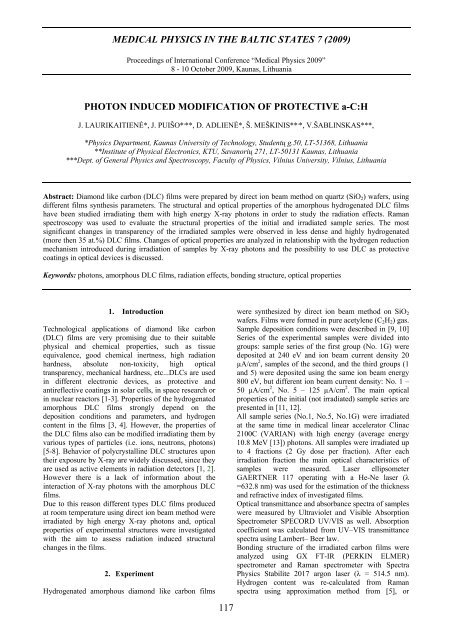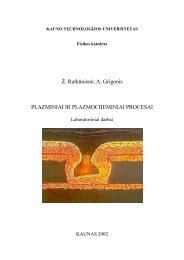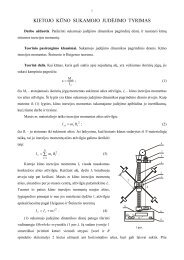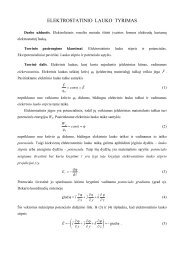PROCEEDINGS OF THE 7 INTERNATIONAL ... - Fizika
PROCEEDINGS OF THE 7 INTERNATIONAL ... - Fizika
PROCEEDINGS OF THE 7 INTERNATIONAL ... - Fizika
You also want an ePaper? Increase the reach of your titles
YUMPU automatically turns print PDFs into web optimized ePapers that Google loves.
MEDICAL PHYSICS IN <strong>THE</strong> BALTIC STATES 7 (2009)<br />
Proceedings of International Conference “Medical Physics 2009”<br />
8 - 10 October 2009, Kaunas, Lithuania<br />
PHOTON INDUCED MODIFICATION <strong>OF</strong> PROTECTIVE a-C:H<br />
J. LAURIKAITIENĖ*, J. PUIŠO* , **, D. ADLIENĖ*, Š. MEŠKINIS** , *, V.ŠABLINSKAS***,<br />
*Physics Department, Kaunas University of Technology, Studentų g.50, LT-51368, Lithuania<br />
**Institute of Physical Electronics, KTU, Savanorių 271, LT-50131 Kaunas, Lithuania<br />
***Dept. of General Physics and Spectroscopy, Faculty of Physics, Vilnius University, Vilnius, Lithuania<br />
Abstract: Diamond like carbon (DLC) films were prepared by direct ion beam method on quartz (SiO2) wafers, using<br />
different films synthesis parameters. The structural and optical properties of the amorphous hydrogenated DLC films<br />
have been studied irradiating them with high energy X-ray photons in order to study the radiation effects. Raman<br />
spectroscopy was used to evaluate the structural properties of the initial and irradiated sample series. The most<br />
significant changes in transparency of the irradiated samples were observed in less dense and highly hydrogenated<br />
(more then 35 at.%) DLC films. Changes of optical properties are analyzed in relationship with the hydrogen reduction<br />
mechanism introduced during irradiation of samples by X-ray photons and the possibility to use DLC as protective<br />
coatings in optical devices is discussed.<br />
Keywords: photons, amorphous DLC films, radiation effects, bonding structure, optical properties<br />
1. Introduction<br />
Technological applications of diamond like carbon<br />
(DLC) films are very promising due to their suitable<br />
physical and chemical properties, such as tissue<br />
equivalence, good chemical inertness, high radiation<br />
hardness, absolute non-toxicity, high optical<br />
transparency, mechanical hardness, etc...DLCs are used<br />
in different electronic devices, as protective and<br />
antireflective coatings in solar cells, in space research or<br />
in nuclear reactors [1-3]. Properties of the hydrogenated<br />
amorphous DLC films strongly depend on the<br />
deposition conditions and parameters, and hydrogen<br />
content in the films [3, 4]. However, the properties of<br />
the DLC films also can be modified irradiating them by<br />
various types of particles (i.e. ions, neutrons, photons)<br />
[5-8]. Behavior of polycrystalline DLC structures upon<br />
their exposure by X-ray are widely discussed, since they<br />
are used as active elements in radiation detectors [1, 2].<br />
However there is a lack of information about the<br />
interaction of X-ray photons with the amorphous DLC<br />
films.<br />
Due to this reason different types DLC films produced<br />
at room temperature using direct ion beam method were<br />
irradiated by high energy X-ray photons and, optical<br />
properties of experimental structures were investigated<br />
with the aim to assess radiation induced structural<br />
changes in the films.<br />
2. Experiment<br />
Hydrogenated amorphous diamond like carbon films<br />
117<br />
were synthesized by direct ion beam method on SiO2<br />
wafers. Films were formed in pure acetylene (C2H2) gas.<br />
Sample deposition conditions were described in [9, 10]<br />
Series of the experimental samples were divided into<br />
groups: sample series of the first group (No. 1G) were<br />
deposited at 240 eV and ion beam current density 20<br />
µA/cm 2 , samples of the second, and the third groups (1<br />
and 5) were deposited using the same ion beam energy<br />
800 eV, but different ion beam current density: No. 1 –<br />
50 µA/cm 2 , No. 5 – 125 µA/cm 2 . The main optical<br />
properties of the initial (not irradiated) sample series are<br />
presented in [11, 12].<br />
All sample series (No.1, No.5, No.1G) were irradiated<br />
at the same time in medical linear accelerator Clinac<br />
2100C (VARIAN) with high energy (average energy<br />
10.8 MeV [13]) photons. All samples were irradiated up<br />
to 4 fractions (2 Gy dose per fraction). After each<br />
irradiation fraction the main optical characteristics of<br />
samples were measured. Laser ellipsometer<br />
GAERTNER 117 operating with a He-Ne laser (λ<br />
=632.8 nm) was used for the estimation of the thickness<br />
and refractive index of investigated films.<br />
Optical transmittance and absorbance spectra of samples<br />
were measured by Ultraviolet and Visible Absorption<br />
Spectrometer SPECORD UV/VIS as well. Absorption<br />
coefficient was calculated from UV–VIS transmittance<br />
spectra using Lambert– Beer law.<br />
Bonding structure of the irradiated carbon films were<br />
analyzed using GX FT-IR (PERKIN ELMER)<br />
spectrometer and Raman spectrometer with Spectra<br />
Physics Stabilite 2017 argon laser (λ = 514.5 nm).<br />
Hydrogen content was re-calculated from Raman<br />
spectra using approximation method from [5], or








